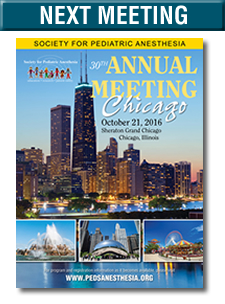Pediatric anesthesiology 2016 reviews
Friday Session V-2: The ABC of CAB-Circulation, Airway, Breathing - Difficult Airway Debate: Three Strikes and You're In!
 Reviewed by Titilopemi Aina, MD MPH
Reviewed by Titilopemi Aina, MD MPH
Baylor College of Medicine and Texas Children’s Hospital
This session was moderated by John Fiadjoe, MD (Children’s Hospital of Philadelphia) and featured a three-pronged debate on difficult airway management. The topics were: All I need is an LMA; Lights, Camera, Action!; and Fiberoptics are Fun.
The first debater was Narasimhan Jagannathan, MD (Ann & Robert H. Lurie Children’s Hospital of Chicago) who started by changing his presentation topic to “All I need is an SGA (supraglottic airway)”. He stated that LMA (laryngeal mask airway) is a subset of supraglottic devices, and advocated the use of the term supraglottic airway (SGA) instead. He initiated the debate by giving 5 reasons for SGA use, namely:
- providing rapid oxygenation
- less invasive nature
- ease of placement for both skilled and unskilled providers
- ability to provide varied modes of ventilation
- utility in airway rescue for difficult intubation and/or laryngoscopy
Dr. Jagannathan went on to state that currently 30 - 50% of anesthetics in children are performed with an SGA. He also highlighted that SGAs have a lower failure rate in children compared to adults. He further argued that children are ideal candidates for SGA use in anesthesia because children need rapid oxygenation, have a higher placement success rate than adults, frequently undergo minor procedures, among others. He went on to present reasons why clinicians are hesitant to use SGAs including:
- surgeon preference
- lack of familiarity
- concern for aspiration
Dr. Jagannathan then discussed complications that occur in difficult airways, with the most common complication being hypoxia. He presented a study published in the British Journal of Anaesthesia1, on the use of SGAs in difficult airways. The study showed SGA use was successful in 96% of cases. He then highlighted that the use of an SGA is a distinct step in most airway algorithms. He argued that one could not effectively oxygenate a patient with a video laryngoscope or fiberoptic bronchoscope.
The second debater was Jamie M. Peyton, MD (Boston Children’s Hospital). Dr. Peyton commenced his argument by stating that video laryngoscopy (VL) improves the laryngoscopic view, increases chance of a successful intubation, facilitates teaching, enables real time documentation of a fundamental anesthetic procedure, and is the natural successor to direct laryngoscopy (DL). He went on to present the reasons for the popularity of the standard DL, such as: simplicity, affordability, longevity, and high success rates in children.
Dr. Peyton then presented rates of difficult intubations in children from 0.5 to 5% of cases. He described the common VL options available: AirTraq, Truview, C-MAC, McGrath, Glidescope. Of all VL attempts, 83% were with the Glidescope. He also noted that contrary to popular belief, there is no evidence of clinically significant differences in time taken to intubate. He also reviewed specific scenarios when VL should not be used, namely, limited mouth opening, previous failed VL, and user inexperience.
Dr. Peyton concluded by arguing that, “All I need is an LMA” is only worthwhile in cases when intubation is not clinically necessary. He did endorse that LMAs (SGAs) are excellent rescue devices, good conduits for fiberoptic intubation while allowing continuous oxygenation/ventilation, and a vital part of modern anesthesia practice. However, he stated that SGAs could fail up to 5% of the time. Dr. Peyton’s argument against fiberoptic bronchoscopy was the need for a complicated and cumbersome setup, and reported cases in the literature of bronchoscopy-related infections.
The third, and final, debater was Thomas L. Shaw, MD (Texas Children’s Hospital, Houston). He started by stating LMA stands for – Lose my Airway. He went on to discuss predictors of a difficult airway including:
- limited mouth opening
- pathology in and around the glottis
- cervical spine deformity
- trauma
He argued that VL is difficult in cases of limited mouth opening, and that the predictors of VL failure are shorter thyromental distance, limited cervical mobility, previous airway surgery, neck mass, and neck radiation. Also, VL could result in trauma to the vocal cords, trachea, dentition, hypopharynx, and tonsils.
Dr. Shaw presented the indications for fiberoptic intubation (FOI):
- restricted mouth opening
- oral masses
- C-spine instability
- hypoplastic mandible
- desire for nasal intubation
Next, he reported the advantages of FOI as:
- reduction in laryngoscopy attempts
- optimal in awake patient
- less stimulation of gag reflex
- more stable hemodynamics
Then, he listed the contraindications to FOI as:
- expected difficult mask ventilation
- massive upper airway hemorrhage
- upper airway obstruction
Dr. Shaw highlighted the results of the PeDI registry study2 that showed, fiberoptic bronchoscopy (FOB) was the first attempt device in 34% of cases (most used). It was also the most successful at 43%.
Dr. Shaw issued an “Educators call to Action” - He argued that if we (faculty) don’t master FOI, then they (trainees) won’t learn during residency/fellowship; and if they (trainees) don’t learn during residency/fellowship maybe they never will. He concluded by presenting the key steps in FOI. He used the term “Fiberoptic Success”, and listed the following steps:
- Focus (able to read fine print on an alcohol pad)
- Fit (FOB through ETT and ETT through LMA)
- Fog (Defogger and/or warm normal saline)
- Suction (Ready)
- Saliva (Prevent with glycopyrrolate)
- Silicone (Lubricate scope and ETT)
- Shrink (Nose with oxymetolazine)
- Secure (ETT on proximal scope)
- Stepstool (to maintain extension of scope)
At the end of the debate, the audience was left to decide who the winner was. The debate was followed by, “Rebuttals, Audience Response Questions, and Discussion.” During this period, a question was raised on the importance of maintaining spontaneous ventilation. The moderator, Dr. Fiadjoe, stated that the PeDI registry2 reported 43% of patients were given neuromuscular blockade prior to airway intervention, and further study is needed to be able to answer this question. The discussion also went on to touch on the possibility of DL becoming antiquated, the response was yes and no; in resource-limited settings DL will continue to be popular, however in high-income countries, advanced airway tools are likely to usurp DL in the near future.
Another question was raised on what other options are available for those in resource-limited settings for advanced airway intervention, and the gum-elastic bougie and lighted stylet were suggested as helpful tools. A final discussion point was on the use of the glidescope in combination with the FOB as a way to optimize the view of the larynx. The technique was commonly used by some in the audience, and it was also noted that the DL blade or manually pulling the tongue will provide the same effect.
References
- Jagannathan N, Sequera-Ramos L, Sohn L, et al. Elective use of supraglottic airway devices for primary airway management in children with difficult airways. Br J Anaesth 2014; 112(4): 742 – 748.
- Fiadjoe JE, Nishisaki A, Jagannathan N, et al. Airway management complications in children with difficult tracheal intubation from the Pediatric Difficult Intubation (PeDI) registry: a prospective cohort analysis. Lancet Respir Med 2016; 4: 37 – 48.





